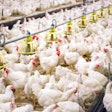
Retail orders for eggs increased dramatically in the beginning weeks of COVID-19-related panic buying. The U.S. Department of Agriculture (USDA) reported for three consecutive weeks that egg inventories were down 10%, which is a rapid decline, especially when higher inventory numbers were expected with Easter approaching, Brian Moscogiuri, director and egg market reporter at Urner Barry explained during the webinar, "Industry Insights From Urner Barry's Egg Office," hosted by Urner Barry on April 28.
"Retailers were being shorted on their orders and the producers were having to go out into the spot market to find supply to fill those orders to make sure customers had eggs on their shelves," he said.
To do that with the limited availability of eggs, market prices increased rapidly in March. Easter did not live up to expectations due to those prices and because consumers had already stocked up on eggs during panic buying.
Retail sales were big news for egg producers when the COVID-19 pandemic started, but where does it now sit? Moscogiuri said when big box stores were hit hard initially, sales of specialty eggs increased, specifically on the edges of the country. Retailers started restricting the number of eggs consumers could buy. "That, along with the price increases, the lack of features and foodservice eggs that began to show up in the industry led to a rapid adjustment of going from $3.09 down to $1.07 through April," he said.
The market now seems to have stabilized somewhat and more eggs are available, so retailers are better able to fill their orders as consumer demand has decreased due to the supply consumers initially built up, he added.
Retail pricing
"One of the key issues we see here (at retail) is that retail pricing tends to lag the wholesale market. A lot of retailers have different contracts associated with wholesale benchmarks, so they will buy on weekly pricing or a four-week rolling average … so it took some time for the retailers to begin passing along the wholesale cost to their customer," Moscogiuri said.
This means that even though the wholesale market was improving and producers were competing with one another to get all eggs available for retail, demand at the retail shelf wasn't slowing for the first week because those costs were not passed along to consumers, he explained. "This is what created the lag between the wholesale market surging and the consumer slowing down that demand, you can see that even still in the retail pricing, even though there is not a lot of features, feature pricing is nowhere near the wholesale market," he said.
Consumers did not see the reaction of the wholesale market at the shelf even though they ran into issues where eggs were not available.
Retailers want to keep prices of eggs low because it keeps people coming into the stores. "Egg is typically used as a loss leader at most of the retailers across the country," he said.
Market disruption
Moscogiuri explained that the industry has seen similar types of highs in the market before, not to this extent but highs, nonetheless. Avian influenza (AI) contributed to some of that but that was much different. "AI was a supply-side issue; the industry lost 11% of production in just a few months and it took some time to rebuild that," he said.
What we are seeing now is almost totally demand-driven, he noted, the closet parallel to this situation was the increase in demand the egg industry saw in 2018 due to brick-and-mortar retailers trying to compete with online grocery delivery.
Foodservice
Limitations put on restaurants have dramatically impacted egg suppliers. Roughly one-third of all eggs produced are broken and half of that egg product is used to service the foodservice sector, Moscogiuri explained. In addition to that, about 7% of all eggs produced go into the foodservice sector in a shell.
"You are talking about roughly 22% of all production that is needed to go into foodservice alone. They're saying that foodservice can be down anywhere between 70 and 80%, so when you're talking about 70 to 80% of that demand being destroyed, you can be looking at 50 to 60 million layers that are in production without a home right now," said Moscogiuri.
That pressure has hurt the egg product market in terms of raw materials, breaking stock and whole eggs. Breaking stock prices only peak out at 68 cents a dozen, now they are at a record low of 15 cents per dozen. "There is nowhere to go with this liquid," he said. Which is evident in the liquid whole egg market that is at a record low of 8 cents a pound compared to the pre-pandemic 55 cents a pound.
"Some processors had built a business model around servicing this (liquid whole egg) industry and they went from having all of their eggs spoken for on a day-to-day basis to having little to no demand from their customer base," he said.
Now those suppliers are forced to do anything they can to alleviate the supply they have. This may include selling shell eggs or cutting back production with molt and/or slaughter.
The slowdown of foodservice has created the availability of eggs for the retail market that is still relatively strong. "There seems to be an adequate supply of egg overall; the problem that the suppliers are having is that they can't get the egg in the right packing," Moscogiuri said.
Loose eggs are available and the U.S. Food and Drug Administration has released a guidance document that will allow producers who normally sell their eggs for foodservice and processing the flexibility to sell those eggs for retail sales, however, retailers don't seem to want loose eggs.
"They don't want to deal with adding additional skews or the handling of these loose packs. Over the years they have worked to set up the specs on these cartons that they want to buy and the production standards for the eggs that they have in their stores that they don't necessarily want to go into the market and buy eggs that were destined for the food processing channel in these loose packs," he said.
This is similar to what the red meat market is experiencing. The supply is there but because processing plants are down, retail cuts are limited therefore cost are surging.

















